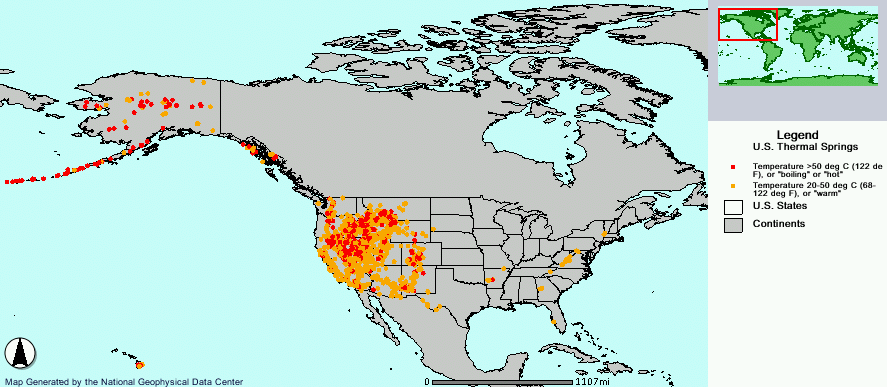Glenwood Springs
A hot spring is a spring that is produced by the emergence of geothermally-heated groundwater from the earth's crust. There are hot springs all over the earth, on every continent and even under the oceans and seas.

Sources of heat
The water issuing from a hot spring is heated by geothermal heat, i.e., heat from the Earth's interior. In general, the temperature of rocks within the earth increases with depth. The rate of temperature increase with depth is known as the geothermal gradient. If water percolates deeply enough into the crust, it will be heated as it comes into contact with hot rocks. The water from hot springs in non-volcanic areas is heated in this manner.
In volcanic zones such as Yellowstone National Park, water may be heated by coming into contact with magma (molten rock). The high temperature gradient near magma may cause water to be heated enough that it boils or becomes superheated. If the water becomes so hot that it builds steam pressure and erupts in a jet above the surface of the Earth, it is called a geyser. If the water only reaches the surface in the form of steam, it is called a fumarole. If the water is mixed with mud and clay, it is called a mud pot.
Warm springs are sometimes the result of hot and cold springs mixing but may also occur outside of volcanic areas.
Flow rates
Hot springs range in flow rate from the tiniest "seeps" to veritable rivers of hot water. Sometimes there is enough pressure that the water shoots upward in a geyser, or fountain.
A very low flow rate hot spring fed the closed resort, Fales Hot Ditch, which is north of Bridgeport, California. There is a huge subterranean lake below Tonopah, Arizona, which provides natural hot mineral waters to several hot springs. These hot springs were used by the seven or more hot spring spas that once operated in Tonopah. The ruins of two such spas are still visible in Tonopah.
These spings, Glenwood Springs have a flow of 143 liters/second.

The inspiration for this Earthcache is the nearby largest natural hot springs pool in the world (pictured above) beside the highway just east of here. Visitors can soak in the therapy pool (104 degrees) or swim in the huge 98-degree swimming pool or play in the small children's pool. The water is full of salty minerals. The Hot Springs Pool is the marque attraction in Glenwood Springs.
This simply named Hot Springs Pool is collectively over two city blocks long, with the large swimming pool holding 1,071,000 gallons of water, and the smaller hot therapy pool holding more than 91,000 gallons of water. These hot springs pools are open year round attracting world-wide visitors.
Logging Requirements :
- (optional)Post a photo of yourself (with GPS ) to prove your visit.
- According to the sign at the coordinates, what did the Ute Indian tribe do with the water from these springs and why?